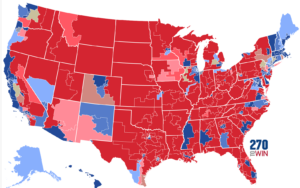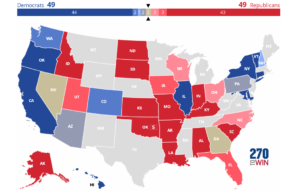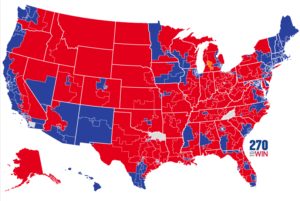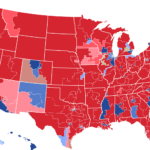As we prepare for the 2020 elections, Yesh Ginsburg and Steen Kirby will give a general overview of all 435 United States House of Representatives races. This is a basic overview to introduce you to the major candidates. All Partisan Lean numbers are taken from the Cook Partisan Voting Index. We will update this page as the races progress if anything noteworthy arises.
California is the most populous state in the nation, with its whopping 53 Congressional Districts. 45 of those currently sit in the hands of Democrats. Of the nine we’ll be looking at in this article, every single one is held by a Democrat. What will the Representatives be like from these districts? Let’s introduce them.
All nine of the districts in this group are currently held by Democrats. In theory, some of these could be tight battles. However, Democrats do hold all of these seats, and are favored in all of these races.
Remember, California runs on a “jungle primary” system. On March 3rd, every candidate interested in running for Congress appeared on the ballot. The top two in each race advanced to the November general election, so there are no write-ins and no third candidates. In some districts, the top two primary candidates are from the same party.
Because of California’s size, we are not putting every candidate in one article. In fact, it takes us six articles to get through all of them. This article looks over Districts 28-36, but we also have gone over all the other districts, linked below.
Districts 1-9
Districts 10-18
Districts 19-27
Districts 37-45
Districts 46-53
California’s 28th Congressional District
Incumbent: Adam Schiff (Democrat, 10th term)
Partisan Lean: D+23
2018 Results:
| Candidate | Votes | % |
| Adam Schiff (D) | 196,662 | 78.37 |
| Johnny Nalbandian (R) | 54,272 | 21.63 |
2016 Results:
| Candidate | Votes | % |
| Adam Schiff (D) | 210,883 | 77.99 |
| Lenore Solis (R) | 59,526 | 22.01 |
Republican Candidate:
Eric Early (campaign website)
Early barely made his way out of the jungle primary, but he’s in this campaign. Unfortunately for him, his chances of winning are very low. He’s a Republican, but his campaign is focusing on two things. He’s trying to claim that Schiff has cared more about national matters than his district, and he’s focusing on California’s controversial AB5.
Democratic Candidate:
Adam Schiff (campaign website)
Schiff doesn’t really need to campaign on anything, and he probably won’t. He has national acclaim for his role in opposing Donald Trump and in the impeachment proceedings. His position on the House Intelligence Committee gives him more clout, which his district seems to appreciate. Schiff has not received less than 60% in an election since 2000, and don’t expect that to change now.
California’s 29th Congressional District
Incumbent: Tony Cardenas (Democrat, fourth term)
Partisan Lean: D+29
2018 Results:
| Candidate | Votes | % |
| Tony Cardenas (D) | 124,697 | 80.61 |
| Benito Bernal (R) | 29,995 | 19.39 |
2016 Results:
| Candidate | Votes | % |
| Tony Cardenas (D) | 128,407 | 74.73 |
| Richard Alarcon (D) | 43,417 | 25.27 |
Republican Candidate:
No Republican candidate qualified for the general election.
Democratic Candidate:
Tony Cardenas (campaign website)
Angelica Duenas (campaign website)
On paper, this looks like a classic race between an establishment Democrat and a progressive. Cardenas is popular, so this will be a tough challenge. However, Duenas seems to go further than the standard progressive line. On top of Medicare for All, a Green New Deal, and a federal jobs guarantee (among other plans), she is proposing a 30-hour work week, a total revamping of the education system, and more. Interestingly enough, she is also proposing setting international standards for robots “so that they do not develop into a threat against humans.”
California’s 30th Congressional District
Incumbent: Brad Sherman (Democrat, 12th term)
Partisan Lean: D+18
2018 Results:
| Candidate | Votes | % |
| Brad Sherman (D) | 191,573 | 73.4 |
| Mark Reed (R) | 69,420 | 26.6 |
2016 Results:
| Candidate | Votes | % |
| Brad Sherman (D) | 205,279 | 72.64 |
| Mark Reed (R) | 77,325 | 27.36 |
Republican Candidate:
Mark Reed (campaign website)
Reed has lost this same race three consecutive times, each time getting a smaller vote share. The entirety of his campaign website is one promotional video and an option to sign up for his email list. He has raised and spent no money in this race, and doesn’t appear to be actively campaigning.
Democratic Candidate:
Brad Sherman (campaign website)
Sherman is a long-term Congressman and a Foreign Affairs committee member. He is a middle-of-the-road Democrat who has been long respected by his district. He has easily beaten Reed three straight campaigns, and there is zero reason to think this one could be different.
Yesh’s notes: Due to his popularity and not facing any serious electoral challenge in a long while, he actually has quite a war chest saved up. (Many of the safe California Congresspeople do, though Sherman’s is bigger than usual even for them.) Given the state of California politics right now, though, it’s hard to see what potential races he could spend that on.
California’s 31st Congressional District
Incumbent: Pete Aguilar (Democrat, third term)
Partisan Lean: D+8
2018 Results:
| Candidate | Votes | % |
| Pete Aguilar (D) | 110,343 | 58.79 |
| Sean Flynn (R) | 77,352 | 41.21 |
2016 Results:
| Candidate | Votes | % |
| Pete Aguilar (D) | 121,070 | 56.07 |
| Paul Chabot (R) | 94,866 | 43.93 |
Republican Candidate:
Agnes Gibboney (campaign website)
Gibboney is at a massive disadvantage in spending, and is running a peculiar campaign. Aguilar is not particularly progressive, and Gibboney is running on an anti-Socialism rights-defending campaign in a district that’s still a bit purple-tinged. That doesn’t seem like a winning combination.
Democratic Candidate:
Pete Aguilar (campaign website)
Aguilar is a three-term Congressman that has outperformed his district’s partisan lean the last two elections. He turned the district blue in 2014 by a slim margin, but he’s been in solid control of this seat ever since. He is a moderate Democrat whose campaign focuses mostly on local issues.
California’s 32nd Congressional District
Incumbent: Grace Napolitano (Democrat, 11th term)
Partisan Lean: D+17
2018 Results:
| Candidate | Votes | % |
| Grace Napolitano (D) | 121,759 | 68.78 |
| Joshua Scott (R) | 55,272 | 31.22 |
2016 Results:
| Candidate | Votes | % |
| Grace Napolitano (D) | 114,926 | 61.57 |
| Roger Hernandez (D) | 71,720 | 38.43 |
Republican Candidate:
Joshua Scott (campaign website)
Scott is trying to win this seat for a second time, after losing by over 37 points in 2018. He is relatively moderate on policy, but is running a conservative culture war style campaign. Maybe the current debate over “cancel culture” will get him a bit more attention than he would have otherwise received, but it’s not like this campaign was ever going to be competitive.
Democratic Candidate:
Grace Napolitano (campaign website)
Napolitano’s campaign website is one of the rare ones that does not provide a platform. And while her House website has a list of “issues,” for all of them it tells readers to contact her office to discover her positions. That doesn’t matter much, though. She’s popular and in a very blue district. She has no electoral concerns for now.
California’s 33rd Congressional District
Incumbent: Ted Lieu (Democrat, third term)
Partisan Lean: D+16
2018 Results:
| Candidate | Votes | % |
| Ted Lieu (D) | 219,091 | 70.02 |
| Kenneth Wright (R) | 93,769 | 29.98 |
2016 Results:
| Candidate | Votes | % |
| Ted Lieu (D) | 219,397 | 66.44 |
| Kenneth Wright (R) | 110,822 | 22.56 |
Republican Candidate:
James Bradley (campaign website)
Wright decided to try again this year, this time attempting a nonpartisan campaign as an independent. It failed, and James Bradley came through the primary to challenge Lieu. Bradley is trying to campaign as an outsider, saying that regular politics has abandoned his section of Los Angeles. With almost no money to spend and against a popular incumbent in a strong Democratic district, it’s unlikely it will go anywhere.
Democratic Candidate:
Ted Lieu (campaign website)
Lieu’s campaign website doesn’t list a platform or issues, but he doesn’t need to. The Congressman is perhaps most famous for his aggressive methods of treating President Trump on Twitter. It seemed to resonate well in his district, as he was more popular in 2018 than 2016, and he ran away with over 60% of the vote in a six-person primary
California’s 34th Congressional District
Incumbent: Jimmy Gomez (Democrat, second term)
Partisan Lean: D+35
2018 Results:
| Candidate | Votes | % |
| Jimmy Gomez (D) | 110,195 | |
| Kenneth Mejia (G) | 41,711 |
2016 Results:
| Candidate | Votes | % |
| Xavier Becerra (D) | 122,842 | 77.23 |
| Adrienne Edwards (D) | 36,314 | 22.77 |
Republican Candidate:
No Republican qualified for the general election.
Democratic Candidate:
Jimmy Gomez (campaign website)
David Kim (campaign website)
Gomez took over this seat after a Special Election in 2017, when then-Representative Xavier Becerra was tapped to become California’s Attorney General. He has not received much national attention, but he has been a progressive voice in Congress, supporting Medicare for All and the Green New Deal. Interestingly enough, Kim is also a progressive. The major policy difference between the pair seems to be Kim’s support for Universal Basic Income, which earned him an endorsement from Andrew Yang.
California’s 35th Congressional District
Incumbent: Norma Torres (Democrat, third term)
Partisan Lean: D+19
2018 Results:
| Candidate | Votes | % |
| Norma Torres (D) | 103,420 | 69.4 |
| Christian Valiente (R) | 45,604 | 30.6 |
2016 Results:
| Candidate | Votes | % |
| Norma Torres (D) | 124,044 | 72.39 |
| Tyler Fischella (R) | 47,309 | 27.61 |
Republican Candidate:
Mike Cargile (campaign website)
Cargile is a pro-Trump Republican running on, among other things, fighting Socialism and advocating for “the sanctity of the Biblical definition of marriage.” It’s an odd plank to run on in California, which litigated the issue much more clearly than any other state (a Wikipedia search for “Prop 8” will still redirect you to the page about California’s ballot measure), though he does frame it more broadly than just that. Still, it’s hard to imagine his candidacy finding much success in this district.
Democratic Candidate:
Norma Torres (campaign website)
Torres is an immigrant from Guatemala who served as a 911 dispatcher in LA for 17 years before transitioning to politics. She is a liberal Democrat with a very strong electoral history in the district. Her campaign website does not show a platform, but that’s less necessary for incumbents as they have voting records to look at.
California’s 36th Congressional District
Incumbent: Raul Ruiz (Democrat, fourth term)
Partisan Lean: D+2
2018 Results:
| Candidate | Votes | % |
| Raul Ruiz (D) | 122,169 | 59.02 |
| Kimberlin Brown Pelzer (R) | 84,839 | 40.98 |
2016 Results:
| Candidate | Votes | % |
| Raul Ruiz (D) | 144,348 | 62.05 |
| Jeff Stone (R) | 88,269 | 37.95 |
Republican Candidate:
Erin Cruz (campaign website)
Cruz defines herself as a “Tea Party conservative,” and she wants to “Make California Golden Again.” She was actively campaigning and has switched that to online due to COVID-19. It’s a weird tactic for a D+2 district, but Ruiz has been far more popular than you’d expect in such a district anyway.
Yesh’s notes: Cruz’s Twitter feed is a collection of very right-wing ideas, including significant questioning and pushback against public officials’ decisions and concerns regarding COVID-19.
Democratic Candidate:
Raul Ruiz (campaign website)
Ruiz is a moderate Democrat who touts his ability to reach across the aisle–and he makes sure that you know he’s a doctor. He has been very popular in this district, outperforming the partisan lean by almost 20 points the last election. He should have nothing to fear moving forward in this one.
Overview
The Democrats will come into the 2020 election with all nine of these seats, and it would take something very surprising to flip any of them at this point.
Interested in the rest of our primers for other House races? We have them all listed on our primer home page.
Interested in the rest of our primers for other House races? We have them all listed on our primer home page.













